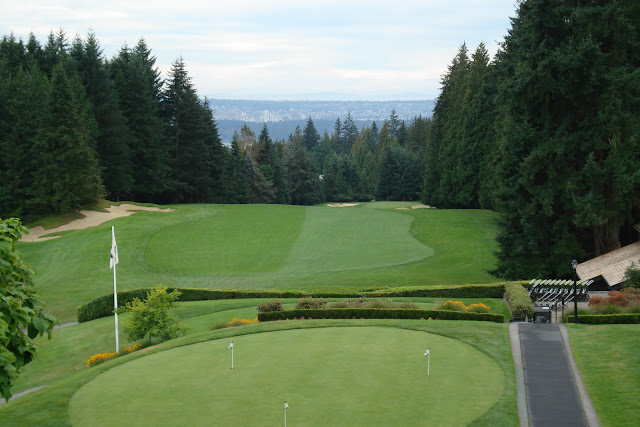Portsea Golf Club is routed over terrific golfing country, featuring wonderfully undulating terrain and a good sandy base. There exists a beautiful simplicity to the design at Portsea, and the fresh breezes blowing off of Bass Strait ensure a nice test of golf over a relatively short course. The golf course started as a nine-hole affair back in 1926 and was finally expanded to a full eighteen from twelve in 1965 by Sloan Morpeth. As golf spread rapidly on the Mornington Peninsula, and competition for rounds increased, Portsea Golf Club endeavoured to improve their course by hiring Michael Clayton. In keeping with his design philosophy, Clayton removed a lot of excess tea-tree in order to widen playing corridors and give golfers greater freedom to play. Strategic bunkers were added and a number of tees were shifted and lengthened to provide a more thorough and rewarding test.
Portsea Golf Club is a quaint facility featuring subtle green contours, a restrained bunkering scheme and a number of elevated tees that provide spectacular views of Bass Strait, Port Phillip Bay and Point Nepean National Park. The rolling terrain is very appealing as a lot can happen to the ball after it lands, both good and bad. I have fond memories of my day at Portsea, and hope that those traveling to golf in Australia give it due consideration.
Post-Script: Since playing Portsea in 2006, the club has sold off the land that used to house the ninth green and tenth tee, and according to Michael Clayton (no longer the consulting architect), this has been a detriment to the quality of the golf course. The existing clubhouse is being abandoned, and a new structure is being build behind the existing fifth green. Sadly the club has abandoned the back tees on No. 6, and turned it into a straight away par 4 that will in the future serve as the first hole, rendering the fairway bunkers obsolete (thankfully they come into play on No. 5, which will become the final hole). It is a real shame to lose this exciting shot, I am glad to have experienced it. I'm not sure whether these changes will affect the current first and eighteenth holes, which will soon feature a long, dis-jointed walk between green and tee. Further, the current seventh, a one-shotter will now play at the second, a scenario that has a bad habit of slowing play early in the round. I wish them success, but fear my return visit will not be as rewarding an experience.
 |
| A solitary bunker guards the front right of the second green, meaning a drive challenging the steep drop-off bordering the left side of the fairway is the ideal line from the tee. |
 |
| The third plays downhill to an green set within an amphitheatre. |
 |
| The fourth hole plays through a gentle valley. |
 |
| Not only is the drive on the fifth hole blind, but the green is completely obscured on the approach by a pair of bunkers set into a ridge short of the green. |
 |
| The seventh plays across a deep gully to a green set in a bowl. |
 |
| The dogleg right ninth is a demanding finish to the outward nine. |
 |
| The tenth green as seen from the crest of the hill that creates a blind drive. |
 |
| The eleventh plays down into a valley and then to an elevated green with a false front. |
 |
| The twelfth plays downhill to a green surrounded by deep bunkers. |
 |
| The driveable thirteenth plays only 267 yards along a ridge. Thoughts of eagles or two-putt birdies need to be weighed against stray drives careening further off-line into deep bunkers. |
 |
| Simple, attractive bunkering guards the green at fourteen, a short par 5. The slope in the foreground can be used to run the ball onto the green around those left side bunkers. |
 |
| A drive carrying between 205-240 yards at fifteen will catapult off a downhill slope into the lower portion of the fairway. |
 |
| The sixteenth plays slightly uphill to an angled green benched into the hillside. |
 |
| The final hole plays through a valley and finishes below the clubhouse. The second shot on the par 5 is complicated by two fairway bunkers residing 40 to 60 yards short of the green. |
Post-Script: Since playing Portsea in 2006, the club has sold off the land that used to house the ninth green and tenth tee, and according to Michael Clayton (no longer the consulting architect), this has been a detriment to the quality of the golf course. The existing clubhouse is being abandoned, and a new structure is being build behind the existing fifth green. Sadly the club has abandoned the back tees on No. 6, and turned it into a straight away par 4 that will in the future serve as the first hole, rendering the fairway bunkers obsolete (thankfully they come into play on No. 5, which will become the final hole). It is a real shame to lose this exciting shot, I am glad to have experienced it. I'm not sure whether these changes will affect the current first and eighteenth holes, which will soon feature a long, dis-jointed walk between green and tee. Further, the current seventh, a one-shotter will now play at the second, a scenario that has a bad habit of slowing play early in the round. I wish them success, but fear my return visit will not be as rewarding an experience.







